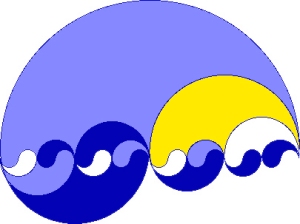Welcome to this week’s Math Munch! And, if you’re a student or teacher, welcome to a new school year!
 One of the most exciting events in the world of math happened this August– the awarding of the Fields Medal! This award honors young mathematicians who have already done awesome mathematical work and who show great promise for the future. It also only happens every four years, at the beginning of an important math conference called the International Congress of Mathematicians, so it’s a very special occasion when it does!
One of the most exciting events in the world of math happened this August– the awarding of the Fields Medal! This award honors young mathematicians who have already done awesome mathematical work and who show great promise for the future. It also only happens every four years, at the beginning of an important math conference called the International Congress of Mathematicians, so it’s a very special occasion when it does!
This year’s award was even more special than usual, though. Not only were there four winners (more than the usual two or three), but one of the winners was a woman!
Now, if you’re like me, you probably heard about the Fields Medal and thought, “There’s no way I’ll understand the math that these Field Medalists do.” But this couldn’t be more wrong! Thanks to these great articles from Quanta Magazine, you can learn a lot about the super-interesting math that the Fields Medalists study– and why they study it.
One thing you’ll immediately notice is that each Fields Medalist has non-math interests that inspire their mathematical work. Take Manjul, for instance. When he was a kid, his grandfather introduced him to Sanskrit poetry. He was fascinated by the patterns in the rhythms of the poems, and the number patterns that he found inspired him to study the mathematics of number patterns– number theory!
But, don’t just take my word for it– you can read all about Manjul and the others in these great articles! And did I mention that they come with videos about each mathematician?
Want to read more about this year’s Fields Medallists? Check out Alex Bellos’s article in The Guardian. Which brings me to…
 … What’s your favorite number? Is it 7? If it is, then you’re in good company! Alex polled more than 30,000 people about their favorite number, and the most popular was 7. But why? What’s so special about 7? Here’s why Alex thinks 7 is such a favorite:
… What’s your favorite number? Is it 7? If it is, then you’re in good company! Alex polled more than 30,000 people about their favorite number, and the most popular was 7. But why? What’s so special about 7? Here’s why Alex thinks 7 is such a favorite:
 Why do you like your favorite number? People gave Alex all kinds of different reasons. One woman said about 3, her favorite number, “3 wishes. On the count of 3. 3 little pigs… great triumvirates!” Alex made these questions the topic of the first chapter of his new book, The Grapes of Math. (Get the reference?) In this book, Alex shares many curious ways that math appears in our world. Did you know that a weird pattern in numbers can be used to catch criminals? Or that the Game of Life, a simple computer program, shares surprisingly many characteristics with real life? These are only a few of the hundreds of topics Alex covers in his book. Whether you’re a math whiz or a newbie, you’ll learn something new on every page.
Why do you like your favorite number? People gave Alex all kinds of different reasons. One woman said about 3, her favorite number, “3 wishes. On the count of 3. 3 little pigs… great triumvirates!” Alex made these questions the topic of the first chapter of his new book, The Grapes of Math. (Get the reference?) In this book, Alex shares many curious ways that math appears in our world. Did you know that a weird pattern in numbers can be used to catch criminals? Or that the Game of Life, a simple computer program, shares surprisingly many characteristics with real life? These are only a few of the hundreds of topics Alex covers in his book. Whether you’re a math whiz or a newbie, you’ll learn something new on every page.
Alex currently writes about math for The Guardian in a blog called, “Alex’s Adventures in Numberland”— but he also loves and writes about soccer (or futbol, as it’s called in his native Brazil)! He even wrote a few articles for his blog about math and soccer.
Do you have any questions for Alex? (About math, soccer, or their intersection?) Write them here and you might find them featured in our interview with Alex!
Good writing about math is hard to find. If you’ve ever picked up a standard math textbook, you’ll know what I mean. But reading something fascinating, that grabs your interest from the first page and leads you through the most complex ideas like they’re as natural as anything you’ve observed, is a great way to learn. The Grapes of Math and “Alex’s Adventures in Numberland” do just that. Give them a go!
Bon appetit!
















